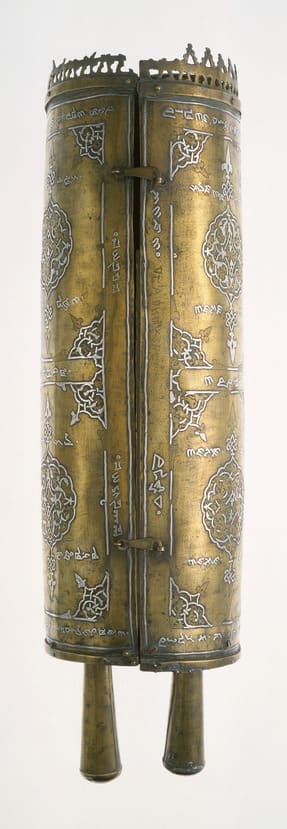
- Object Name:
- Torah Case
- Artist/Maker:
- Matar Ishmael ha-Ramhi
- Bio:
- active mid-16th-early 17th century
- Title:
- Samaritan Torah Case (Tik)
- Place Made:
- Damascus (Syria)
- Date:
- 1568
- Medium:
- Copper: inlaid with silver
- Dimensions:
- 24 1/4 × 7 in. (61.6 × 17.8 cm)
- Credit Line:
- The H. Ephraim and Mordecai Benguiat Family Collection
- Accession Number:
- S 21
Not On View
In antiquity, cloth mantles or bags (tikim) were used to protect the Torah scroll, the most sacred object in Judaism. By the eleventh century, rigid cases, also called tikim, were made from wood, copper, and silver, according to an inventory of 1059 from the Jerusalemite Synagogue that was found in the Cairo Genizah, a repository for old and worn Hebrew texts dated from the eighth to the thirteenth century. This case belongs to the earliest group of Torah cases to have survived; all five were made for the Samaritan community in the Near East during the sixteenth century. Three are still in use in the community today, while the fourth is at the University of Michigan.
Shortly before the fabrication of the tik in 1568, political power in the region had passed from the Mameluke Dynasty to the Ottomans. Nevertheless, the style and forms of Mameluke art continued to be used as on this case, where the silver inlays form circular fields with pointed terminals. Arabesques fill the fields, forming an area of dense ornament, which is repeated in the corners of the surrounding rectangular frames. Except for inscriptions, the remainder of the field is blank, forming an effective contrast with the ornamented areas. The same system of decoration was used on Mameluke and Ottoman book covers made in the sixteenth century.
When enclosed in a tik, the Torah is set in a vertical position and rolled by means of its staves. The manner of its use is the opposite of that of a Torah protected by a mantle. In that case, the textile mantle is removed, and the Torah scroll is laid flat for reading during the service.
Before the modern period, Torah cases were used in Spain and the Spanish diaspora, in North Africa, and in Near Eastern communities. The large-scale emigration of Jews from Arab lands after the founding of the State of Israel in 1948 brought many tikim to the West, leading to their adoption by traditional Ashkenazic communities.
Shortly before the fabrication of the tik in 1568, political power in the region had passed from the Mameluke Dynasty to the Ottomans. Nevertheless, the style and forms of Mameluke art continued to be used as on this case, where the silver inlays form circular fields with pointed terminals. Arabesques fill the fields, forming an area of dense ornament, which is repeated in the corners of the surrounding rectangular frames. Except for inscriptions, the remainder of the field is blank, forming an effective contrast with the ornamented areas. The same system of decoration was used on Mameluke and Ottoman book covers made in the sixteenth century.
When enclosed in a tik, the Torah is set in a vertical position and rolled by means of its staves. The manner of its use is the opposite of that of a Torah protected by a mantle. In that case, the textile mantle is removed, and the Torah scroll is laid flat for reading during the service.
Before the modern period, Torah cases were used in Spain and the Spanish diaspora, in North Africa, and in Near Eastern communities. The large-scale emigration of Jews from Arab lands after the founding of the State of Israel in 1948 brought many tikim to the West, leading to their adoption by traditional Ashkenazic communities.
Information may change as a result of ongoing research.